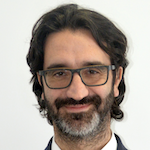Invited Speaker
| |
|

|
"Tactile perception"
by Pr. Francesco MASSI
Professor
University of Rome, "La Sapienza"
Roma, Italia
Human senses make possible our perception of the surrounding world. While sight and hearing are largely understood and mastered, the sense of touch is far from being achieved. The origin of touch stays in the mechanical stimuli that “transduce” the physical properties of the touched surfaces in signals, processable by the brain. The identification and analysis of such stimuli is a necessary step for their recording and reproduction, for mimicking tactile perception. Recent works focused on friction-induced vibrations, generated by the scanning of fingertip on a surface, allowing for identifying their main contribution in the discrimination of surface textures. Being tactile perception at the bridge between several fields, from tribology to psychology, passing by neuroscience and engineering sciences, the research is developed within a research consortium (GdR TACT) interconnecting different research disciplines. The mimicking of tactile stimuli has been obtained, allowing for discriminating surfaces, by measuring and reproducing the corresponding induced vibrations.
|
|

|
"Biomechanical challlenges in Plastic Surgey."
by Dr. Francesco MARCHETTI
Specialista in Chirurgia Plastica Ricostruttiva ed Estetica
Italian Board certified Plastic Surgeon
International ASPS member
Challenging situations are daily reencountered in Plastic Surgery, due to the interactions between organic materials (skin, organs, fluids), inorganic ones (silicone, fillers) and medical devices used by surgeons to lead at good term the surgery. Nevertheless, a lack in efficient medical instrumentation is often evident. As an example, spreading of silicone in case of implant rupture could cause lymphatic deposits during years, inflammation and necrosis. When removing the implant, surgeon is faced to the lack of specific devices that could assure a clean process in a reduced operating time for surgery. Because of the several specialities and specific situations that must be handled in surgery, dialogue between clinicians and engineers is needed for the development of more effective and innovative medical devices.
|

|
"Ways of improving hydrodynamic sliding bearings:
recent studies and industrial applications."
by Pr. Michel FILLON
CNRS Director of Research
Co-Editor-in-Chief of Tribology International
Fellow of ASME, Fellow of STLE, AFM member
Poitiers, France
For new applications, more efficient sliding bearings are very often proposed. The improvement of these hydrodynamic bearings can be obtained by using new coating materials (PTFE, PEEK) instead of a Babbitt layer (even if this solution could be satisfactory for more classic industrial applications). The composite materials permit to reduce friction during startup and under nominal operation. Furthermore, due to their thermal insulating properties, these polymers reduce the pad backing temperature and, consequently, the thermal deformations. New designs of more advanced fluid film bearings also offer gains in terms of performance; as an example, the partially textured parallel surface thrust bearing can be cited. In addition, new designs can also enlarge the domain of applications: a very recent example is the concept of “FlexPad,” which is a Conical sliding bearing proposed for the wind turbine main bearing.
|
|
|
|
|




